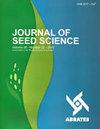Eugenia属植物切分种子新根的起源
IF 1.2
4区 农林科学
Q3 AGRONOMY
引用次数: 1
摘要
摘要/ Abstract摘要:对优生植物胚芽分化后种子萌发的研究表明,子叶细胞具有去分化和产生根的能力。然而,没有关于这些新词根起源的信息。因此,本研究的目的是解剖表征五种Eugenia种子的子叶区域,以阐明产生这种根的组织。种子横切在丘陵区域,并立即放置发芽。一旦这些被切割的种子长出了根,它们就会被固定起来,并用通常的光学显微镜技术进行处理。不定根仅在种子分蘖时产生,在未损伤的种子中不会自发产生。不定根由维管周围薄壁细胞形成,位于子叶损伤区附近。这些细胞沿茎周分裂并增殖,形成根分生组织。因此,新幼苗的基因组可能与母株不同,但它们与受精后的胚胎是相同的。本文章由计算机程序翻译,如有差异,请以英文原文为准。
The origin of new roots from cut seeds of Eugenia species
Abstract: Studies on seed germination in Eugenia species after embryo fractionation have demonstrated that cotyledon cells have capacity for de-differentiation and consequent production of roots. However, there is no information about the origin of those new roots. Thus, the aim of this study was to characterize anatomically the cotyledon regions of seeds of five species of Eugenia to elucidate the tissue that originates such roots. Seeds were sectioned across the hillum region and immediately placed to germinate. As soon as the fractions of these cut seeds develop roots they were fixed and processed to the usual techniques for light microscopy. The adventitious roots originated only when the seed was fractioned, never occurring spontaneously in uninjured seeds. Adventitious roots were formed from perivascular parenchyma cells, located close to the injured region of the cotyledons. These cells divided periclinally and proliferated, giving rise to a root meristem. Therefore, new seedlings probably have a different genome than the mother plant, but they would be identical to the embryo that was a result of fertilization.
求助全文
通过发布文献求助,成功后即可免费获取论文全文。
去求助
来源期刊

Journal of Seed Science
Agricultural and Biological Sciences-Agronomy and Crop Science
CiteScore
2.00
自引率
30.00%
发文量
28
审稿时长
12 weeks
期刊介绍:
From 2017 the Journal of Seed Science (JSS) will circulate online version only.
Original scientific studies and communications, not yet published or submitted to another journal for publication and written in Portuguese or English, will be accepted for publication. For manuscripts submitted in English, the authors should provide an adequated version.
The SCIENTIFIC COMMUNICATION is a category of scientific manuscript which describes a technique, an equipment, new species or observations and surveys of limited results. It has the same scientific rigor as the “Scientific Articles” and the same value as a publication. The classification of a manuscript as a SCIENTIFIC COMMUNICATION is based on its content and scientific merit but it can be a preliminary study, simple and not definitive on a certain subject, with publication justified by its uniqueness and contribution to the area.
The Editorial Board of the JSS may invite leading authors of recognized reputation to compose specific Review Articles covering topics of their specialization that will convey to the scientific community the state-of-the-art knowledge related to the specific theme.
 求助内容:
求助内容: 应助结果提醒方式:
应助结果提醒方式:


